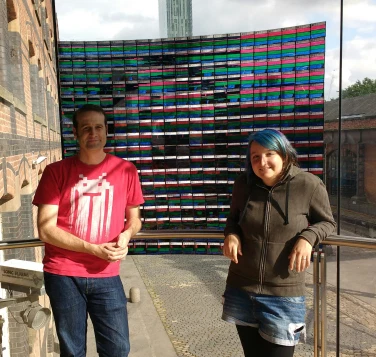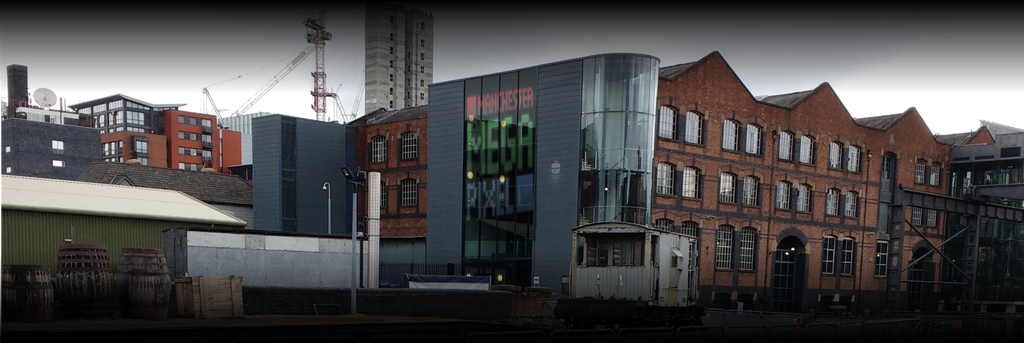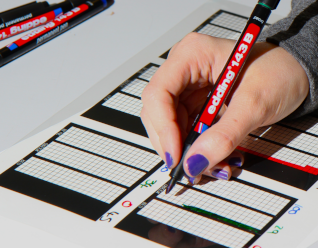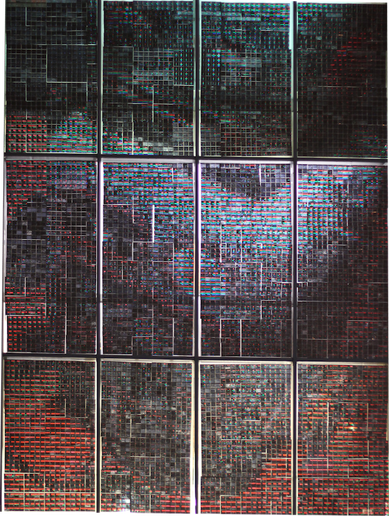Case Study: Manchester MegaPixel Project
Organisations involved: Matt Parker, Katie Steckles, Stand-up Maths Limited/Think Maths, Manchester Science Festival, Joshua Phillips Award, University of Salford
Case study written by: Katie Steckles
Intended audience: Visitors to the Science and Industry Museum during Manchester Science Festival – families (including children down to age 8) and individuals/groups of adults
Maths content: RGB displays and storing images as numbers; proportion and percentages
Audience group: Primary or Elementary, Lower secondary or Middle school, Upper secondary or High school, Sixth Form or Junior College, Families (adults and children), University Students, Young Adults, Adults, Retired
Audience interest level: Engaged, Receptive, Expert
Topics: Hands-on, computer science, number

The MegaPixel project took place in 2016 as part of Manchester Science Festival, as a joint project with Think Maths. Katie Steckles was the lead and organiser on the project, and it was funded by the Joshua Phillips Award and the University of Salford, and supported by Edding.
Visitors to the Science and Industry Museum during Manchester Science Festival – families (including children down to age 8) and individuals/groups of adults – were invited to take part in an activity and learn about RGB displays and storing images as numbers, as well as proportion and percentages.
Origins of the Project
Katie was awarded the 2016 Joshua Phillips Award for Innovation in Science Engagement, which came with a budget to deliver an activity as part of Manchester Science Festival. She had helped deliver large-scale mass-participation hands-on activities as part of the Festival previously, and working with Matt Parker and the team at Think Maths developed the idea of creating a giant pixel image to illustrate the way display screens store colours as numbers.
As well as being a way to communicate the maths and science behind RGB displays, the project would involve every visitor to the museum being given the chance to participate in creating an image on display at the museum. This would allow people to feel part of something, while also watching a large, exciting and visual display take shape.

Practicalities
The image took up all four floors of a window which ran the full height of the building, and was made from ‘pixels’ of acetate about 10cm square, each of which was coloured using red, green, blue and black permanent markers in different proportions depending on the colour of the pixel. MegaPixel had a stall and tables in the front entrance of the museum where people could come and hear about what they were doing, take a pixel or a few to colour in, and return them to go into the finished image. Anyone who did this got a sticker reading ‘I made a pixel for the MegaPixel!’.

A ‘hack day’ was organised ahead of the event to develop the hardware and software, at which we implemented a pixel scanner, and a system that generated stickers to go on each pixel for sorting. Working with with a local FabLab hackspace, a callout was made for volunteers on Twitter and through the Science Festival. This attracted some local makers, coders and mathematicians, who also helped deliver the activities at the festival. The volunteers were all given a t-shirt with the project logo, and refreshments provided during the event, and received briefings and training on how to interact with the public.
A website was built for the project, and Katie promoted MegaPixel on Twitter and with a YouTube video on Matt Parker’s channel ahead of the project, to encourage people to join in/visit. Visitors to the museum for other Science Festival events could participate as they entered the museum, on their way to other events happening onsite. The event was also advertised through the Science Festival’s website and printed programme, distributed to communities around Manchester.
To attach the pixels to the window, a high access platform and safety equipment were hired. This required some liaison with the museum on PPE and procedures. The pixel sections were sellotaped to the window (cleaning the tape marks off the window after the project was completed also had to be costed in). Edding donated all the pens needed, and were an official sponsor of the project – having approached several other major permanent marker companies, with the offer of publicity (sending out pens to schools and using them on the day) and sponsor credit in return for pens, Edding responded. The project budget covered acetates, tape, printing, stickers, equipment and t-shirts/refreshments for the team.
As well as the pixel colouring activity, the stall also had some other worksheets exploring RGB and Hex colours, and a microscope to allow people to examine phone and tablet screens closely and see the pixels are made up of red, green and blue segments. There were also red, green and blue light torches to demonstrate colour mixing, and a photo booth which converted photos taken into pixelated versions, which were printed on the spot for participants to take away (also developed by the Hackday team).

Some sections of pixels, along with activities, coloured gels for torches, and marker pens, were sent out in packs to schools and other organisations who coloured them ahead of time and posted them back. These were incorporated into the finished picture. During the festival, the team completed all but the top few rows of the image, which could be seen from in the yard outside the museum.
Accessibility
The colouring and activities were completed on tables in the main foyer of the museum, which was wheelchair accessible, and explanations and support were available from our team. It was possible to participate with a variety of levels of understanding – simply colouring in the right number of squares, or knowing how this relates to technology. Written explanations were available on the worksheets as well as a spoken explanation. Participating involved speaking to one of our team to take and return pixels and receive instructions, but at any given time multiple team members were available, and tried to be approachable and friendly. The activity was not suitable for participants with visual impairment, as the pixels were small and needed to be seen in order to colour them in.
The project also provided materials online for people to generate and complete their own mini-MegaPixel images at home, and a satellite event at the University of Bath made use of this to complete a smaller image of Leonhard Euler, which they hung in a window in their maths department.
More information
Project website: megapixel.katiesteckles.co.uk
Twitter account: twitter.com/mcrmegapixel